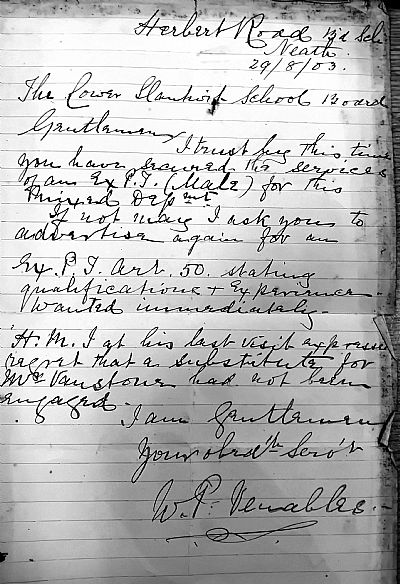William Purcell Venables
A Dedicated Headmaster
TUDOR THOMAS
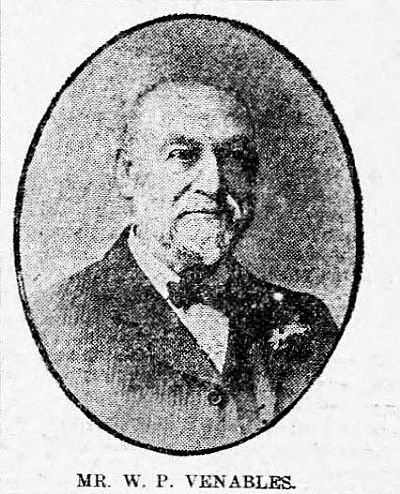
William Purcell Venables was the first headmaster of the Melyn Infants’ school. He was appointed in April 1874 and dedicated 35 years of his life to educating children in the Melyncryddan schools. His life makes interesting reading and allows us to reflect on education in the late nineteenth century.
It is worthwhile to commence with an address he gave at his retirement function in July 1909 in response to his retirement presentation and the address given in his honour, as in his response he related his first coming to Wales and his experiences in education over 48 years. The Cambrian News reporter was truly impressed and printed the speech in full as detailed below:
Neath Notes - The Cambrian July 1909
He made a very interesting speech in reply to the presentation, and I make no apology of giving it in extenso as I’m sure the reading of it will be appreciated. Here it is:-
“I beg most heartily to tender my sincere thanks to the subscribers to this most excellent gift which I receive of you this evening, and especially to the committee who organised this testimonial, Also Mr D H Madge, the secretary, who must have exerted much energy to Mr Geo. Williams, the treasurer, for the safe custody of the various subscriptions.. I trust I will be spared a few more years in the neighbourhood and enjoy your good society. I thank all for this excellent testimonial and this beautifully illuminated address. It is out of my line to address a public audience, but before I close my remarks I should like to give you a short biography of myself. I promise you it shall be brief.
I was born in Bury St Edmunds in the county of Suffolk on 7th February 1839, and was brought to Wales when very young, in the old coaching days, along the Old road just outside here, and probably we changed horses where the present building stands. When old enough I was sent to a private school at Herbrandston in, South Pembrokeshire. As time went on I was sent to a private school in Haverfordwest and although an expensive one, I did not learn much there; rudimentary work was not thoroughly explained. Mr Ellis was a clever man and an excellent pen-man but suffered much from gout and many of us took advantage of copying work from each other on our books which was of course ruinous to our success.
As time went on my parents took a farm at Uzmaston, near Haverfordwest. There was a national school here and a lucky day for me that I entered it, here I began to understand what I was really doing. I became a P.T. (pupil teacher) here and served 5 ½ years. I successfully passed the examinations and gained a Queens Scholarship and entered St. Marks College Chelsea London, where I was trained for two years -1858-1860- and got my certificate; but not securing a situation on leaving, I went to an uncle in Hampshire at Beaulieu Abbey , where he was the architect on the estate. Here I smoked my first pipe of tobacco. I thought it would be my last. Some of you may guess. why Oh !
In April 1861 I accepted the headmastership of Tavernspite School in Pembrokeshire, under our late Bishop Lewis of Llandaff. I was there for 13 years, during which time some hundreds of boys and girls were educated. Here I took my wife and here the majority of my children were born. I was very happy here and had plenty of shooting and fishing, but as my children were growing, I thought it was time to make a move, and fortunately I was appointed master of the Melyn boys’ school which opened on April 1st 1874 under Messrs Leach Flower and Co, and remained under their good management till 1895, a period of 21 years, then under the Llantwit School Board till the end of April 1899- four more years, four months- making 25 years four months in the Melyn School.
I was transferred to Herbert road in May 1899 and served there up to February 28th 1909 – nine years ten months making a total service as headmaster for 48 years two months, and I am thankful I am here to tell the tale.
During my stay at Melyn Schools 2771 boys were educated and at Herbert Road 2664 children, a total of 5435. I am pleased to say that many hold lucrative positions all over the world and I trust they are an honour to me, an honour to themselves and an honour to their country”
As he detailed in his speech, William Purcell Venables was born in Bury St Edmunds on 7th February 1839. His parents were John, an Agricultural Labourer, born in Pembrokeshire and his wife Elizabeth Mary, born in Farnham. It appears his parents spent some time in Pembrokeshire where their first son John was born before moving to Bury St Edmunds where William was born together with his younger brother Philip in 1842, prior to moving back to Pembrokeshire before 1851. This can be confirmed from the relevant census returns for those years, recoding his home in 1851 in Uzmanston with his father being a farmer of 60 acres. At that time the lengthy journey of more than 300 miles would have been quite an undertaking for the family and particularly arduous for the young William. On their journey to west Wales, as William reflected at his retirement function, it was quite likely that they would have stopped temporarily in Neath for a change of horses. At the time there were a number of coaching inns in Neath, so it is difficult to ascertain where they may have rested. However, he did indicate that he thought that they travelled through Melyncryddan and paused near St Catherine’s Hall, where the retirement function was taking place, for a change of horses.
William was schooled in Pembrokeshire, initially attending a private school in Hebraston and a second in Haverfordwest. He flourished educationally and he became an ex pupil teacher between 1854 and 1859. On commencing this role he would have been only fifteen years of age. In this era when pupils achieved an acceptable standard of education they could obtain a position as a pupil teacher to the younger pupils in the school, obviously a more economic situation that employing a qualified assistant master or mistress. Most schools in this era had a mix of assistant teachers and ex pupil teachers under a Headmaster. He obviously continued his education whilst fulfilling this role and as a result of his progress at school and hard work he was successful in passing a number of examinations leading to The Queen’s Scholarship which was a passport to higher education. He was subsequently enrolled in St Mark’s College in Chelsea, London to obtain a teaching diploma of the day. He studied here from 1859 to 1860 and received his teaching qualification. He did not secure a post initially and so for a time he lived with an uncle until 1861 when he was successful in being appointed to the headmastership at Tavernspite School, Pembrokeshire at the age of 22 remaining there for 13 years until 1874. Whilst teaching at Tavernspite School he lived in a school cottage and during this time he married his wife Jane Searle in 1865 and six of his children were born, William John, George G, Gilbert Searle, Sydney, Arthur and Dora Maria. On moving to Neath, after taking up the headmastership of Melyn Schools, his seventh child Vernon Voyle was born.
In 1873 there was a major educational development in Melyncryddan, when Mr P W Flower co-owner of the Melyn Tinplate Works, decided to finance and have a school constructed nearby. A drawing of the school was publisher in The Builder publication where it was described as a fine building.
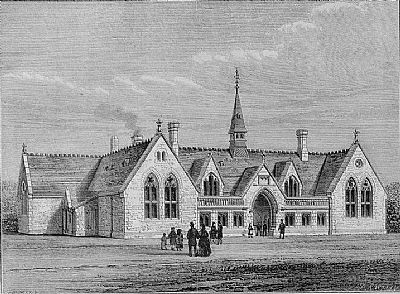
William Venables was appointed its first headmaster in April 1874 and continued in this role for a total of 25 years in the original school. The school motto ‘Manners Makyth Man’, was proposed by Mr Flower because of his links to the Wykeham family and Winchester School (where motto originated); it remains the school motto to this day. It was a sentiment which appears core to Mr Venables’ ethos as a Headmaster. Under his stewardship the school flourished and he most certainly witnessed many changes during his time as Headmaster, both educationally and in terms of the school management. During his tenure the school was enlarged in stages, by modification to the original building and the provision of a separate infants school which was later enlarged.
Another major change that he witnessed and no doubt played a role in, was the change in management with the Llantwit Lower Schools Board taking on this role in 1895. This was short lived as in 1897 the school was purchased by The Neath School Board with Llantwit Lower Board continuing to manage the school while the Herbert Road school was being commissioned and constructed on their behalf. These were uncertain times for the staff at the Melyn school as in 1898 the year prior to the opening of the Herbert Road schools, it transpired that they would be expected to apply for their existing posts under the new board. Mr Venables made representation to the Neath board for clarification of the situation through concern for the welfare of the staff under his Headship.
The Herbert Road school building was finally completed and officially opened in April 1899 under the management of the Llantwit Lower School Board, with the first pupils admitted from the 1st May 1899. Such was the Board’s confidence in William Venables, that these new premises were entrusted to him and he was appointed as the first headmaster for the new Herbert Road school. He remained at Herbert Road as headmaster for 10 years until his retirement in February 1909 at the ripe old age of 70. He was due to retire in 1908 at the age of 69 but the Llanwit Lower board met and voted to retain his services for a further year. It was noted that Mr Venables was the longest serving headmaster in the county at that time. Thus the children of Melyncryddan could be considered fortunate to have the privilege of having William Venables as a headmaster for such a length of time. While headmaster of Herbert Road he was joined by one of his sons Mr Vernon Voyle Venables as an assistant teacher.
His total years of service to education amounted to 48 years with 35 of these devoted to the Melyn Schools.
William Venables lived in a number of different premises in the Neath area including 88 Briton Ferry Road (1881 census) and 103 Clifton Terrace(1891 census) which is now that part of Briton Ferry Road from Quar Road toward Melyncryddan, as shown in the map below;
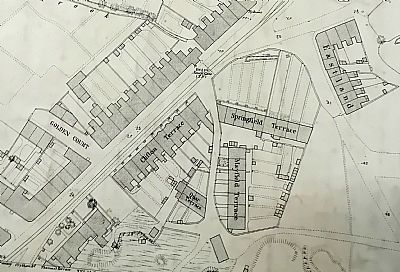
O.S. Map 1877
He finally took up residence at 83 London Road in early 1900 where he remained until his death with his widow Jane and son Vernon remaining there. She passed away in 1916 and Vernon in 1940. Vernon’s widow remained there until 1960, passing away in early 1961, with no children succeeding her.
Prior to his retirement moves were afoot to recognise his service to the Melyn Schools and to honour him with a suitable function: as was noted in the Neath Notes of The Cambrian newspaper on 19th February 1909.
‘I am delighted to learn, and so will you that a movement is on foot at Melycryddan to raise a testimonial to Mr. W P Venables, the oldest schoolmaster in Neath who is about to retire. Mr Venables has proved himself a model schoolmaster and I have not the slightest doubt that there will be a cordial response to the efforts of the committee. One thing has always impressed me about Mr Venables, and that is the veneration with which he is regarded by the group of young people who have so much to thank him for and do not forget to thank him either. Mr. Venables has been and is an excellent man- a tender guide to the young- a fine moulder of character. I have not the slightest doubt that his testimonial will be a thoroughly representative one.’
On the 26th February 1909, his last day as headmaster of Herbert Road School, the scholars and teachers gathered to say farewell and he was presented with what was described as a handsome gold ring with monogram and inscription. Unfortunately, the school log of the time gives no indication of this monogram or the inscription. The presentation was made by Miss Brewer, one of the teachers, on behalf of all the staff and scholars who had subscribed to the gift. Mr W S Jones presented him with a purse containing the remainder of the subscription monies.
Following his retirement he was honoured with a function at St Catherine’s Parish Hall where he received many plaudits and was the recipient of a cheque for 100 guineas, which would be equivalent to approximately £15,000 today. The chair for the event was Mr JW Price, and the presentation was made by Lieutenant Colonel Gardner. The evening was a most enjoyable event with an illuminated address in his honour, a suitable response from Mr Venables and a music programme. The esteem in which he was held as a headmaster and valued member of the community of Neath can be judged from this section of the address which appeared in the Evening Express on 25th June 1909;
‘……..Your retirement commends itself to us as a fitting opportunity of recognising your sterling qualities as a citizen and also the invaluable educational work you have carried out among the children of three generations. It is the earnest wish of all your friends that you may be spared many years of happiness and prosperity.’
[His response is given at the start of this article].
William Venables continued to live in 83 London Road until he passed away in August 1915 at the age of 77. He had experienced a period of ill health, finally succumbing to heart failure. He was laid to rest in Llantwit Old Cemetery in Neath after a service in St Thomas’ Church. He had 9 children in all, with seven surviving and living with him and his wife as recorded on the 1881 census. BMD records show twin girls born in the last quarter of 1867 but sadly passing away in the second quarter of 1868. On the 1911 census there were 5 children still alive, one of his sons Arthur having passed away in 1894 and another George, passing away some time prior to 1911. William, who was a monitor in the Melyn Schools in his younger days, later secured a teaching post in Llantrisant. He passed away in 1912.
Newspaper accounts record that a large number attended the funeral which included family, the Mayor of Neath, other dignitaries, friends and many ex-pupils. It is obvious from the reports that he was held in great esteem by those he educated as well as being a valued member of the community of Neath. The account in the Herald of Wales and Monmouthshire Recorder reads:
‘No townsman of Neath had ever performed better service to the community than the gentleman who for 35 years controlled educational work of an important and lasting character at the Melyn Schools. And certainly no townsman was ever held in higher esteem. Hundreds of old boys long since out in the world cherish affectionate memory of the kind and gentlemanly master who guided their footsteps and firmly paved for them the road to future success.’
He was survived by three of his sons, Gilbert, Vernon and Sidney and his daughter Dora. His youngest son Vernon continued to live with his mother in London Road and by 1901 was a class teacher in the Herbert Road School. Later he was headmaster of the school in Mile End Row and can be seen in the foreground of the photograph of the school below (as recorded on the reverse of the image, which also states that his brother Sidney was a manager of the Tinplate Decorating Works).
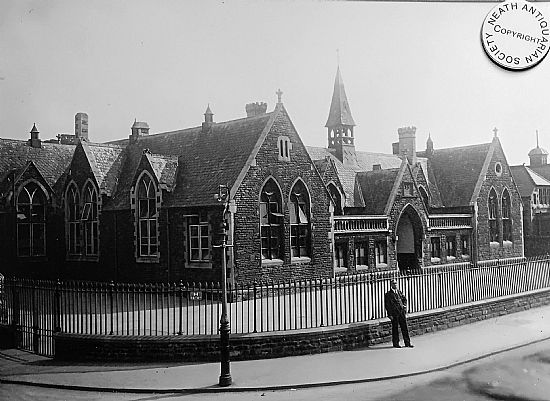
NAS Collection
Vernon Voyle Venables was initiated into the Cambrian Lodge of Freemasons on 20th October 1908. He married Ethel Gertrude West at Manchester in 1931 and continued to live in London Road with her until he passed away on 22nd October 1940, having retired from teaching by 1939. All in all, the Melyn Schools were privileged to have a Venables teaching there for a total of 65 years.
To close this account I have included a copy of a letter that Mr Venables wrote to the Llantwit Board in 1903. Here he requests that the Board acquires the services of an ex-pupil teacher and brings to the Board’s attention that the latest visit by Her Majesty’s Inspector expressed regret that a substitute had not yet been appointed to replace a former member of staff. His signature from 123 years ago concludes this account of a remarkable gentleman.
